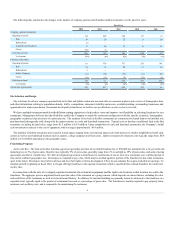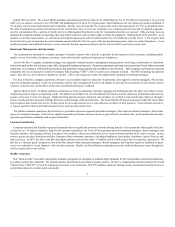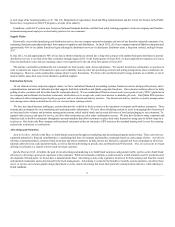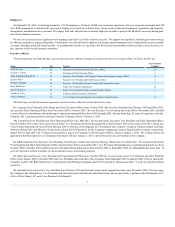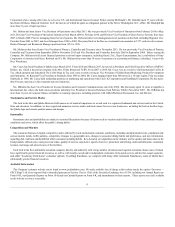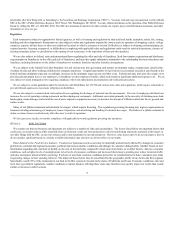Jack In The Box 2013 Annual Report Download - page 16
Download and view the complete annual report
Please find page 16 of the 2013 Jack In The Box annual report below. You can navigate through the pages in the report by either clicking on the pages listed below, or by using the keyword search tool below to find specific information within the annual report.
are located. We have engaged and may engage in real estate development projects. As is the case with any owner or operator of real property, we are subject to
eminent domain proceedings that can impact the value of investments we have made in real property and are subject to other potential liabilities and damages
arising out of owning, operating, leasing or otherwise having interests in real property. In addition, we are subject to a variety of federal, state and local
governmental regulations relating to the use, storage, discharge, emission and disposal of hazardous materials. Failure to comply with environmental laws
could result in the imposition of severe penalties or restrictions on operations by governmental agencies or courts of law, which could adversely affect
operations. We are unaware of any significant hazards on properties we own or have owned, or operate or have operated. Accordingly, we do not have
environmental liability insurance for our restaurants, nor do we maintain a reserve to cover such events. In the event of the determination of contamination on
such properties, the Company, as owner or operator, could be held liable for severe penalties and costs of remediation, and this could result in material
liability.
Risks Related to Leverage. As of September 29, 2013, the Company has a credit facility comprised of a $400.0 million revolving credit facility and a
$190.0 million term loan. We may also request the issuance of up to $75.0 million in letters of credit. For additional information related to our credit facility,
refer to Note 7, Indebtedness, of the notes to the consolidated financial statements. Increased leverage resulting from borrowings under our credit facility could
have certain material adverse effects on the Company, including but not limited to the following:
•our ability to obtain additional financing in the future for acquisitions, working capital, capital expenditures and general corporate or other purposes
could be impaired, or any such financing may not be available on terms favorable to us;
•a substantial portion of our cash flows could be required for debt service and, as a result, might not be available for our operations or other
purposes;
•any substantial decrease in net operating cash flows or any substantial increase in expenses could make it difficult for us to meet our debt service
requirements or force us to modify our operations or sell assets;
•our ability to operate our business as well as our ability to repurchase stock or pay cash dividends to our stockholders may be restricted by the
financial and other covenants set forth in the credit facility;
•our ability to withstand competitive pressures may be decreased; and
•our level of indebtedness may make us more vulnerable to economic downturns and reduce our flexibility in responding to changing business,
regulatory and economic conditions.
Our ability to repay expected borrowings under our credit facility and to meet our other debt or contractual obligations (including compliance with
applicable financial covenants) will depend upon our future performance and our cash flows from operations, both of which are subject to prevailing
economic conditions and financial, business and other known and unknown risks and uncertainties, certain of which are beyond our control. In addition, to
the extent that banks in our revolving credit facility become insolvent, our ability to borrow to the full level of our facility could be limited.
Risks of Market Volatility. Many factors affect the trading price of our stock, including factors over which we have no control, such as reports on the
economy or the price of commodities, as well as negative or positive announcements by competitors, regardless of whether the report relates directly to our
business. In addition to investor expectations about our prospects, trading activity in our stock can reflect the portfolio strategies and investment allocation
changes of institutional holders and non-operating initiatives such as a share repurchase program. Any failure to meet market expectations whether for sales,
growth rates, refranchising goals, earnings per share or other metrics could cause our share price to drop.
Risks of Changes in Accounting Policies and Assumptions . Changes in accounting standards, policies or related interpretations by accountants or
regulatory entities may negatively impact our results. Many accounting standards require management to make subjective assumptions and estimates, such as
those required for stock compensation, tax matters, pension costs, litigation, insurance accruals and asset impairment calculations. Changes in those
underlying assumptions and estimates could significantly change our results.
Litigation.We are subject to complaints or litigation brought by former, current or prospective employees, customers, franchisees, vendors, landlords,
shareholders or others. We assess contingencies to determine the degree of probability and range of possible loss for potential accrual in our financial
statements. An estimated loss contingency is accrued if it is probable that a liability has been incurred and the amount of loss can be reasonably estimated.
Because lawsuits are inherently unpredictable and unfavorable resolutions could occur, assessing contingencies is highly subjective and requires judgments
about future events. We regularly review contingencies to determine the adequacy of the accruals and related disclosures. However, the amount of ultimate loss
may differ from these estimates. A judgment that is not covered by insurance or that is significantly in excess of our insurance coverage for any claims could
materially adversely affect our financial condition or results of operations. In addition, regardless of whether any claims against us are valid or whether we are
found to be liable, claims may be expensive to defend, and may divert management’s attention away from operations and hurt our performance. Further,
adverse publicity resulting from claims may harm our business or that of our franchisees.
14


